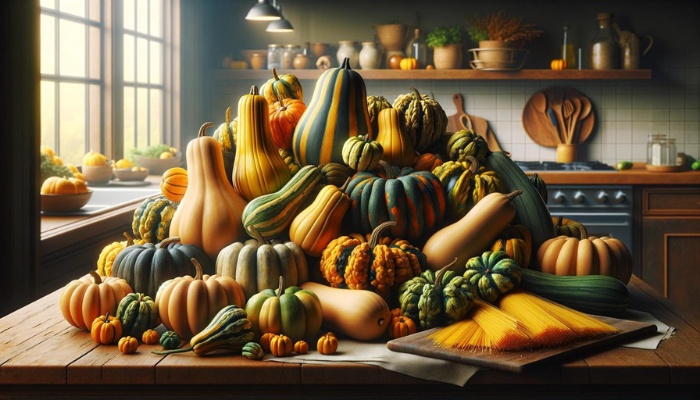To manage squash in your square foot garden, start with compact Cucurbita pepo or Cucurbita moschata varieties. These are suited for limited spaces and exhibit resistance to common pests and diseases, like powdery mildew and vine borers.
Begin cultivation indoors using a high-grade seed starting mix, and then gradually acclimatize seedlings to outdoor conditions.
In your garden layout, amend soil with organic material for superior drainage and aeration, and use one square per plant. Trellising promotes vertical growth and maximizes space while minimizing soil-borne disease risks.
Implement regular pruning and introduce slow-release fertilizers alongside organic compost for soil enrichment. Fine-tune these practices, and you’ll uncover additional strategies for a thriving, manageable squash garden.
Choosing the Right Varieties
When selecting squash varieties for square foot gardening, choose cultivars, such as Cucurbita pepo or Cucurbita moschata, that are well-suited to compact spaces and have disease-resistance traits.
Squash, being a vigorous grower, requires varieties that can thrive within the confined space of a square foot garden without succumbing to common diseases.
Disease resistance is very important. Look for varieties that are resistant to powdery mildew and squash vine borers, two prevalent issues that can devastate squash crops.
Cultivars such as ‘Bush Acorn’ and ‘Butterbush’ not only exhibit compact growth habits but also possess inherent disease resistance, making them ideal for dense planting environments.
Seed starting is another critical aspect to consider. Starting seeds indoors allows you to control the growing environment and ensures that your plants are healthy and robust before transplanting them into your garden.
Use a high-quality seed starting mix and keep the soil moist but not waterlogged. To prevent transplant shock, harden off seedlings by gradually exposing them to outdoor conditions over a week.
Planning Your Garden Layout
It’s imperative to carefully plan your garden’s layout to maximize yield and ensure plant health. Begin with soil preparation, integrating ample organic material into the top 6 to 12 inches of soil.
This enhances drainage and aeration, which are crucial for squash root systems. To provide essential nutrients throughout the growing season, incorporate a balanced, slow-release fertilizer.
Next, consider companion planting to optimize space and promote a healthy garden ecosystem.
Marigolds (Tagetes spp.) and nasturtiums (Tropaeolum majus) can deter pests, while herbs like dill (Anethum graveolens) and oregano (Origanum vulgare) attract beneficial insects.
Place these companions strategically around your squash plants to leverage their natural pest-repellent properties.
Allocate at least 1 square foot per squash plant, ensuring enough room for root expansion and air circulation. This spacing reduces the risk of fungal diseases, which thrive in cramped, moist conditions.
The success of your square foot garden hinges on precise layout planning, soil health, and companion planting strategies to nurture robust squash plants.
Vertical Gardening Techniques
To maximize your square foot garden’s potential, consider employing vertical gardening techniques, such as trellising, to optimize space and improve air circulation around your squash plants.
By guiding these vigorous climbers onto support structures, you’ll not only save valuable ground space but also facilitate healthier growth and easier harvesting.
First, select appropriate climbing aids. Trellises, cages, or sturdy netting are excellent choices. Ensure these structures are securely anchored in the ground to withstand the weight of mature plants.
For optimal support, use materials like wooden stakes or metal poles as the framework for your trellis, and attach a mesh or netting that provides ample space for tendrils to grasp.
Installation of these climbing aids should occur shortly after planting to avoid disturbing the roots of young squash plants.
Gently guide the tendrils toward the support structure, ensuring even distribution to prevent overcrowding and promote uniform airflow.
As the fruits grow, use netting to support their weight, allowing the trellis to carry the weight rather than the vines.
Incorporating vertical gardening techniques into your square foot garden not only maximizes your growing area but also significantly reduces the risk of soil-borne diseases by elevating the foliage and fruits off the ground.
With careful planning and the right support structures, your squash. will thrive, producing an abundant harvest without overwhelming your garden space.
Pruning and Maintenance Tips
Regular pruning and maintenance ensure optimal health and productivity. Pruning isn’t just about aesthetics; it’s important for disease prevention and promoting vigorous growth.
Start by identifying and removing any leaves or stems showing signs of fungal infections or pest damage. Use sterilized pruning shears to cut these sections back to healthy tissue, preventing the spread of pathogens.
Additionally, thinning out dense foliage improves air circulation, significantly reducing the risk of powdery mildew and other common squash diseases.
Aim to remove older, lower leaves that receive less sunlight and contribute minimally to photosynthesis. This practice not only enhances disease resistance but also directs the plant’s energy toward fruit development.
Soil enrichment is another vital aspect of squash care. Incorporate organic matter, such as compost or well-rotted manure, into the soil around your plants.
This boosts nutrient levels, improving overall plant health and resilience against pests and diseases. A well-nourished plant can better withstand the stress of pruning and is more likely to produce a bountiful harvest.
Prioritize these maintenance tasks to cultivate robust, productive squash plants in your square foot garden.
Harvesting and Storage Strategies
Monitor your squash plants closely, as optimal harvest times are key for ensuring peak flavor and texture in your squash.
To determine readiness, observe the rind’s hardness; it should resist puncture by a fingernail. Additionally, the stem will exhibit a dry, corky appearance.
Once harvested, employ specific curing methods to extend storage life, particularly for winter varieties.
Curing involves placing the squash in a well-ventilated area with ideal temperatures ranging between 80 and 85°F (27-29°C) for approximately 10-14 days.
This process enhances the storage capability by hardening the skin further and healing any minor damages.
Post-curing, transfer your squash to a cooler, dark storage environment, maintaining temperatures between 50 and 55°F (10-13°C) with relative humidity around 50-70%. These conditions reduce the risk of rot and maintain quality over several months.

